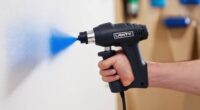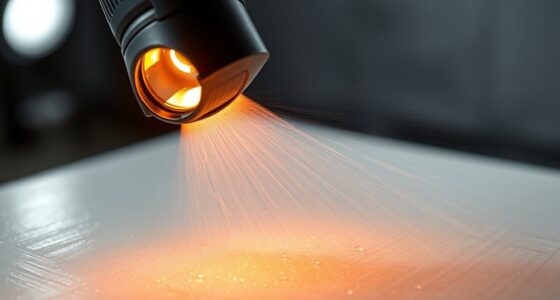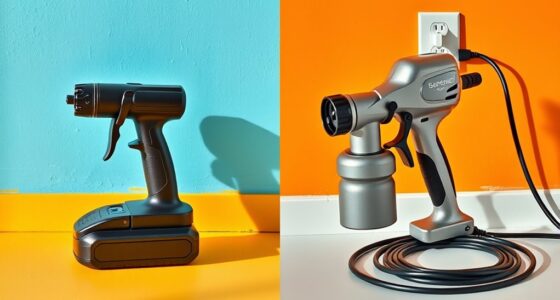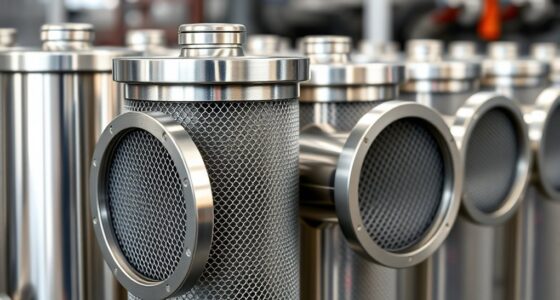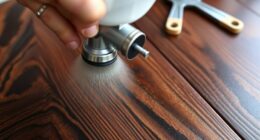When spray painting, it’s essential to wear the right protective gear. Use masks with proper filters to prevent fumes from entering your lungs, ensuring a tight fit for maximum safety. Wear suits that block overspray and fumes while remaining comfortable, especially if you work long hours. Don’t forget goggles to shield your eyes from splashes and particles. Choosing the correct gear and fitting it properly helps keep you safe—discover more tips to get fully protected.
Key Takeaways
- Properly fitted masks and respirators ensure maximum filtration and prevent unfiltered air from entering the breathing zone.
- Protective suits create a barrier against overspray, fumes, and chemicals, especially when paired with ventilation systems.
- Goggles and eye protection prevent irritation, chemical burns, and injuries from debris or splashes during painting.
- Choosing breathable, chemical-resistant materials enhances comfort and safety for prolonged spray painting sessions.
- Advanced safety features like adjustable straps and seal integrity optimize protection and reduce fatigue during use.
Types of Masks and Their Uses
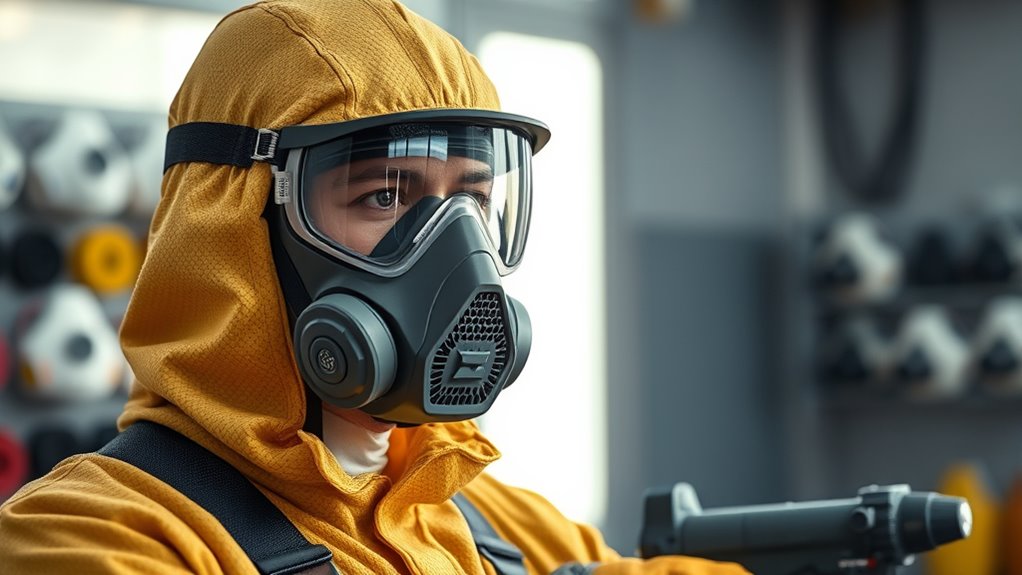
Have you ever wondered which mask provides the best protection when spray painting? The answer depends on the mask’s respirator filtration and how comfortable it feels during extended use. Half-face respirators are popular because they offer excellent filtration against paint fumes and particles while remaining relatively comfortable. They usually feature replaceable filters designed to trap harmful particles effectively. Proper fitting is essential for ensuring a tight seal and optimal protection. Additionally, proper fit and comfort can significantly influence the overall effectiveness of protective gear during spray painting. Seal integrity is crucial to prevent unfiltered air from bypassing the filters and entering the breathing zone. Full-face masks provide additional eye protection and better respiratory filtration, ideal for prolonged projects. Comfort is also vital; a well-fitting mask prevents air leaks and reduces fatigue. Look for adjustable straps and lightweight materials to improve mask comfort. Remember, the most effective mask is one that you wear properly and consistently, ensuring maximum protection with minimal discomfort. Ensuring proper fit and comfort can significantly influence the overall effectiveness of protective gear during spray painting.
Protective Suits for Paint Spraying
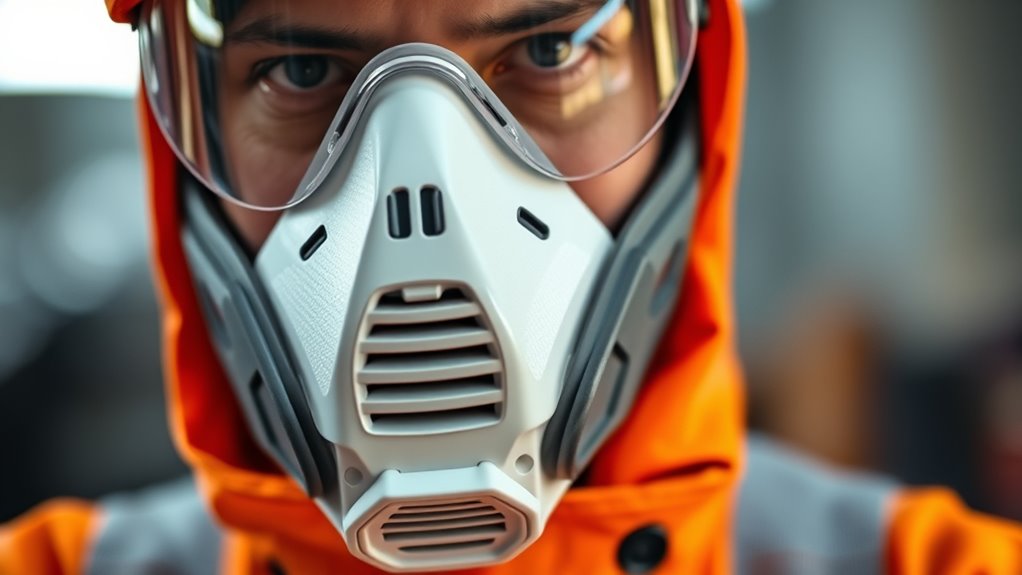
When spray painting, protecting your skin and clothing from overspray and hazardous fumes is just as important as choosing the right mask. Protective suits create a barrier against paint, chemicals, and fumes. To maximize safety, consider these key features:
Protect your skin with breathable, chemical-resistant suits for safe spray painting.
- Make certain the suit is compatible with ventilation systems to prevent heat buildup and improve airflow.
- Look for suits made from breathable, chemical-resistant materials for comfort and protection.
- Always pair your suit with a proper paint respirator to filter out fumes effectively.
- Selecting suits with chemical-resistant materials ensures durability against hazardous substances and enhances overall safety during paint spraying.
- Awareness of AI and automation advancements can help you stay informed about new safety technologies in protective gear.
Additionally, choosing suits with advanced protective features can further improve safety and comfort during prolonged use.
Importance of Goggles and Eye Protection
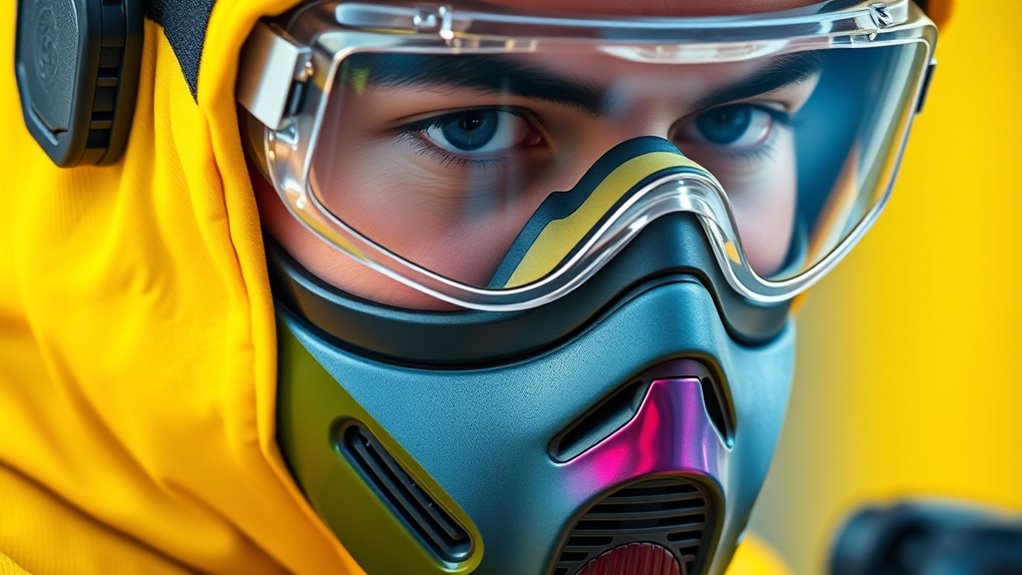
Why is eye protection essential during spray painting? Spray paint releases fine particles and fumes that can easily irritate or damage your eyes. Goggles and eye protection act as a crucial barrier, preventing eye injuries caused by splashes, overspray, or debris. Proper eye gear also supports ventilation safety by reducing exposure to harmful vapors directly reaching your eyes. Without protection, you risk serious injuries like corneal scratches or chemical burns, which can impair your vision. Wearing goggles ensures you stay safe and maintain clear sight while working. By prioritizing eye injury prevention, you protect yourself from unnecessary discomfort or long-term damage. Never compromise on eye protection—your vision depends on it. Choose goggles that fit well and are designed for spray painting to maximize safety. Additionally, Research companies thoroughly before investing in protective gear to ensure quality and safety standards are met. Incorporating proper safety equipment can significantly reduce the risk of injury and improve your overall work experience.
Frequently Asked Questions
How Often Should I Replace My Paint Spraying Mask Filters?
You should replace your paint spraying mask filters regularly to guarantee essential safety and filter performance. Follow the manufacturer’s recommendations for filter replacement, typically every 24 to 40 hours of use or when you notice breathing becomes harder. Adhering to safety standards is vital, so don’t ignore signs of clogging or damage. Regular filter replacement keeps your mask effective, protecting you from harmful fumes and particles during your projects.
Are There Eco-Friendly Options for Protective Gear in Painting?
You’re wondering if eco-friendly options for protective gear exist. Yes, many brands now use eco-friendly materials like recycled fabrics and sustainable manufacturing practices. These options help reduce environmental impact while keeping you protected. Look for gear made from biodegradable or non-toxic materials, and support companies committed to sustainability. By choosing eco-conscious protective gear, you’re contributing to a healthier planet without sacrificing safety during your painting projects.
Can I Wear Goggles Over Prescription Glasses?
Did you know that about 65% of people wear prescription glasses daily? You can definitely wear goggles over your prescription glasses, but it’s important to guarantee compatibility. Use goggle fitting tips, like choosing goggles with adjustable straps and enough space to comfortably fit over your glasses. This way, you stay protected without sacrificing comfort or vision. Just test the fit before painting to avoid any gaps or discomfort.
What Are the Signs of Protective Gear Failure During Spraying?
During spraying, you’ll notice signs of protective gear failure through visual indicators like cracks or holes in masks, suits, or goggles. Fit issues become apparent if the gear feels loose or uncomfortable, allowing paint or fumes to seep in. If you experience fogging goggles, difficulty breathing, or paint getting inside your mask, it’s a clear sign you need to replace or adjust your protective gear immediately to stay safe.
How Do I Properly Clean and Maintain My Protective Suits?
To keep your protective suits in top shape, follow proper cleaning techniques and suit maintenance routines. After each use, rinse the suit with mild soap and water, then hang it to air dry away from direct sunlight. Regularly inspect for tears or damage, and repair or replace as needed. Store the suit in a cool, dry place, ensuring it’s clean and free of contaminants to maintain its protective qualities.
Conclusion
Did you know that proper protective gear can reduce your exposure to hazardous paint fumes by up to 90%? By choosing the right mask, suit, and goggles, you not only safeguard your health but also guarantee a cleaner, safer workspace. Remember, investing in quality gear is vital—your lungs, skin, and eyes will thank you. Don’t cut corners; prioritize your safety every time you pick up that spray gun.
A seasoned painter with over 15 years in the industry, Mike transitioned from hands-on painting projects to the digital world of paint sprayers. His extensive experience gives him a unique perspective on what users truly need when it comes to painting tools. As the Editor in Chief of Paint Sprayer Zone, Mike ensures that every piece of content not only provides value but also reflects the realities of painting — the challenges, the joys, and the intricate details.

